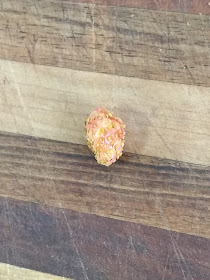I grow this because it tastes great and it pretty much looks after itself. It self seeds easily and pretty much does its own thing. I sprinkle seeds in new places I would like it to grow. Other than that I don't do anything to look after it, I just harvest the leaves or pull it out if it is growing somewhere I don't want it to. It grows fast and flowers a lot, so I let it grow anywhere I have removed vegetables and dig it in as a green manure prior to planting the following crop.
 |
| Hover flies love organic wasabi salad herb!!! |
Hover Fly (family Syrphidae) is a beneficial pollinator that is native and relatively common here. When I was a child people would often try to tell me they were stingless native bees, but they aren't. They are true flies. Don't let the fact that they are flies put you off, they are great insects to have around. They are excellent pollinators, they don't bite or sting or annoy people, and their larvae eat aphids and scale insects. What is not to like!
Hover flies, along with pretty much every other beneficial pollinator insect, also the flowers of love wasabi salad herb. When the weather is warm they try to work the flowers and collect nectar. Often large numbers are seen darting among the flowers. They don't stay on a flower long because honey bees often chase them away. I guess the little amount of nectar they collect before being chased away is worth it as they are always close by.
 |
| Wasabi herb flowering and setting seed, also borage in the background |
I keep trying to take a picture, but they are so fast and wary that they tend to dart off as soon as I try. The pictures on this blog page show these amazing hover flies on some wasabi herb flowers that had self seeded in my yard. I scared some away, then more came, so I was able to get a couple of pictures. Sometimes there can be over 20 of these amazing creatures all foraging on the one flower head!
 |
| Wasabi herb flowers - a pollinator's paradise |
When I have a large stand of wasabi salad herb in cooler weather it hums with all the hover flies and other beneficial insects. When the weather is warmer larger stands hum with the familiar sound of honey bees. When the weather is just right, not too hot not too cold, it hums with a mix of native insect pollinators along with some honey bees. It really is a great little plant to have growing in the garden.
 |
| Wasabi salad herb self seeded in my yard and attracts beneficial insects |
It appears that growing wasabi salad herb organically is one way to help a host of beneficial insects. Over summer I often see different species of native solitary bees foraging upon it, this summer I should try to count how many species. It is good for honey bees, it is good for native pollinators, it is good for many different beneficial insects.
I wish more people in my area would grow it so the local populations of beneficial insects would have more resources, and my honey bees would have more high quality plants to forage upon.
 |
| Cold days mean hover flies are slower and easier to photograph |
I am told that this plant is not allowed in Western Australia. I can't sell seeds or plants to WA due to domestic quarantine, but if you live over there you should probably steer clear of this plant altogether.
I grow everything organically, and so should you. By growing organically you can encourage beneficial insects such as hover flies which are excellent pollinators and help to control (but not eliminate) several pests.
I sell seeds of wasabi salad herb. If you are interested it is listed on my for sale page along with other seeds and perennial vegetables.
 |
| I scared the hover flies away by accident, and more came to replace them |






















































